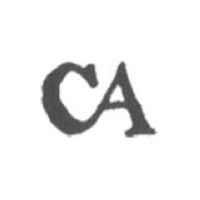
Image 010202-02-01
Used between 1884 and 1914, the first mark used by Carl Auvera.
The history of some factories can be quite confusing, expecially when the normal timelines are often obstructed by takeovers and mergers. One of the most confusing parts in German porcelain industry is the development of the factories in Arzberg and Schönwald which was mainly influenced by the factories in Kahla, Hohenberg and Selb. One part of this history requires that one is comfortable with the existence of the two Hutschenreuther factories: the Carl Magnus Hutschenreuther factory from Hohenberg and the Lorenz Hutschenreuther factory from Selb, both of which merged in 1969 to form the Hutschenreuther AG which is also mentioned here.
In addition, the special status of the Kahla AG should be taken into account - after Germany split in 1949, the town of Kahla and the largest portion of the Kahla company was located in East Germany; a part of the stock corporation however was located in West Germany and should be treated as 'independent' factory as it was simply cut off from it's mother company and was later assimilated by the Hutschenreuther AG. So hold in mind that this Arzberg entry you are just about to read is not to be confused with the 'Arzberg' brand and factory that Hutschenreuther acquired from Kahla in 1972!
When looking at the dates given for the founding of the factory owned by Lorenz Christof Äcker one will find that most sources either show 1838 or 1839. The 'correct' dating is simply a point of view and depends on what somebody would accept as founding date, because construction of the factory started in 1838 while the actual company registration took place in 1839. It should be noted that no official mark registrations can be found; in fact I have so far not been able to find any reference to marks used by Äcker at all.
There are various sources that claim Auvera founded his own company around 1880 and later took over the factory owned by Äcker. That story however is absolute nonsense and the registration records show that Auvera was not even a partner of Äcker, he simply purchased the factory from him in 1884 and instantly renamed it.
It is often mentioned that the Hutschenreuther company took over the business, however many people miss a vital point: the Auvera family was closely involved with Hutschenreuther and hence the term 'friendly merger' might me more appropriate. For example both Carl Auvera and his son Hugo became board members of the C.M. Hutschenreuther AG, and Hugo Auvera continued as shareholder and board member of the Porzellanfabrik C. Tielsch & Co. AG in the town of Altwasser (Silesia). This may not seem interesting at first glance, but C.M. Hutschenreuther took over the Silesian enterprise in 1932 with Hugo Auvera being one of the directors that had influenced the deal. But even before that, Hugo Auvera had already influenced the Silesian business in favour of Hutschenreuther; for example the C.M. Hutschenreuther exports under the 'Black Knight' label (owned by Graham & Zenger, New York) that carry the 'Waldenburg Studios' addition were actually made at the Tielsch factory; a business relationship for which Auvera signed responsible.
Following the merger of both Hutschenreuther companies in 1969, work in the former C.M. Hutschenreuther Arzberg factory was slowly cut back as production was evenly distributed to other factories. After the 1972 acquisition of the Kahla assets including the traditional Porzellanfabrik Arzberg brand, the Hutschenreuther group closed the former C.M. Hutschenreuther factory, their main interest now being the Porzellanfabrik Arzberg factory and brand previously used by Kahla.

Image 010202-02-01
Used between 1884 and 1914, the first mark used by Carl Auvera.
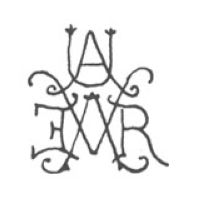
Image 010202-02-02
Used between 1914 and 1918, Registered at the RWZR under №·192·262 on April 21st 1914. Look closely and you can puzzle together "Auvera".
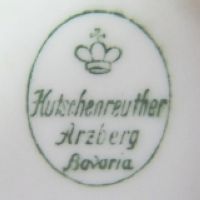
Image 010202-03-01
Used between 1918 and 1945, "Hutschenreuther" above "Arzberg" and "Germany".
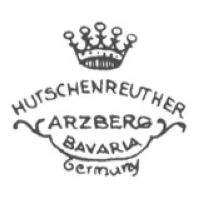
Image 010202-03-02
Used between 1918 and 1945, "Hutschenreuther" above "Arzberg" and "Germany".
(Picture: molotok.ru)
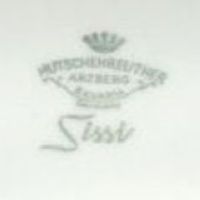
Image 010202-03-03
Used between 1928 and around 1963, example from the "Sissi'"series.
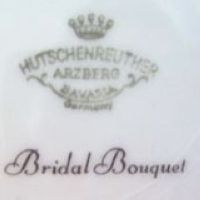
Image 010202-03-04
Used between 1928 and around 1963, example from the "Bridal Bouquet" series.
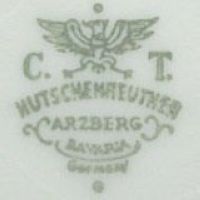
Image 010202-03-05
Used after 1945 until around 1949. Introduced after losing the Porzellanfabrik Tielsch & Co. factory in Altwasser.
(Picture: Sue Ross)
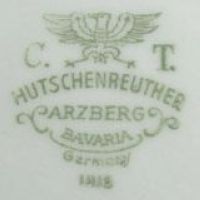
Image 010202-03-06
Used after 1945 until around 1949, here an example from the "Iris" series.
(Picture: Sue Ross)
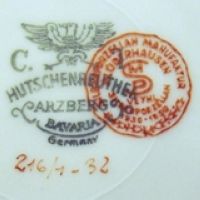
Image 010202-03-07
Used after 1945 until around 1949, here an example (re)decorated 1950/51 by the Manfred Veyhl company.
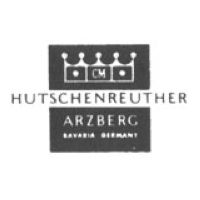
Image 010202-03-08
Used between 1969 and 1972.
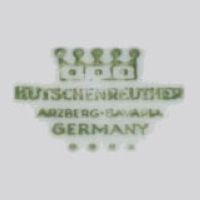
Image 010202-04-01
Used between 1969 and 1972, the last mark used before the two Hutschenreuther companies merged.
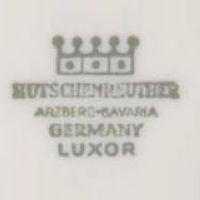
Image 010202-04-02
Used between 1969 and 1972, here with series name "Luxor".
© 2004-2026 C.S.Marshall, all rights reserved